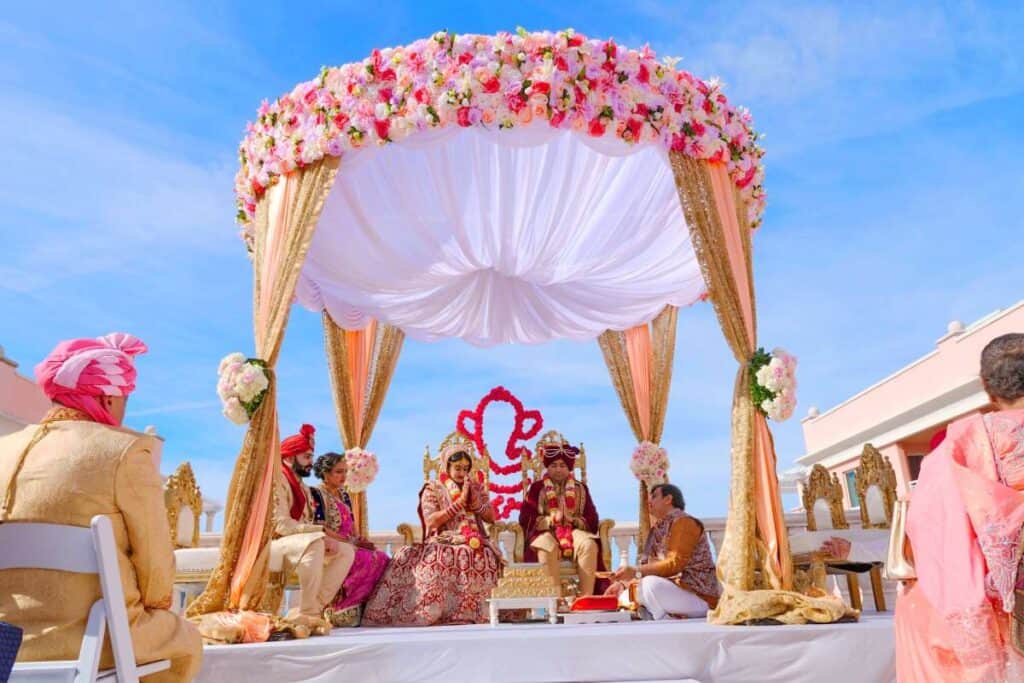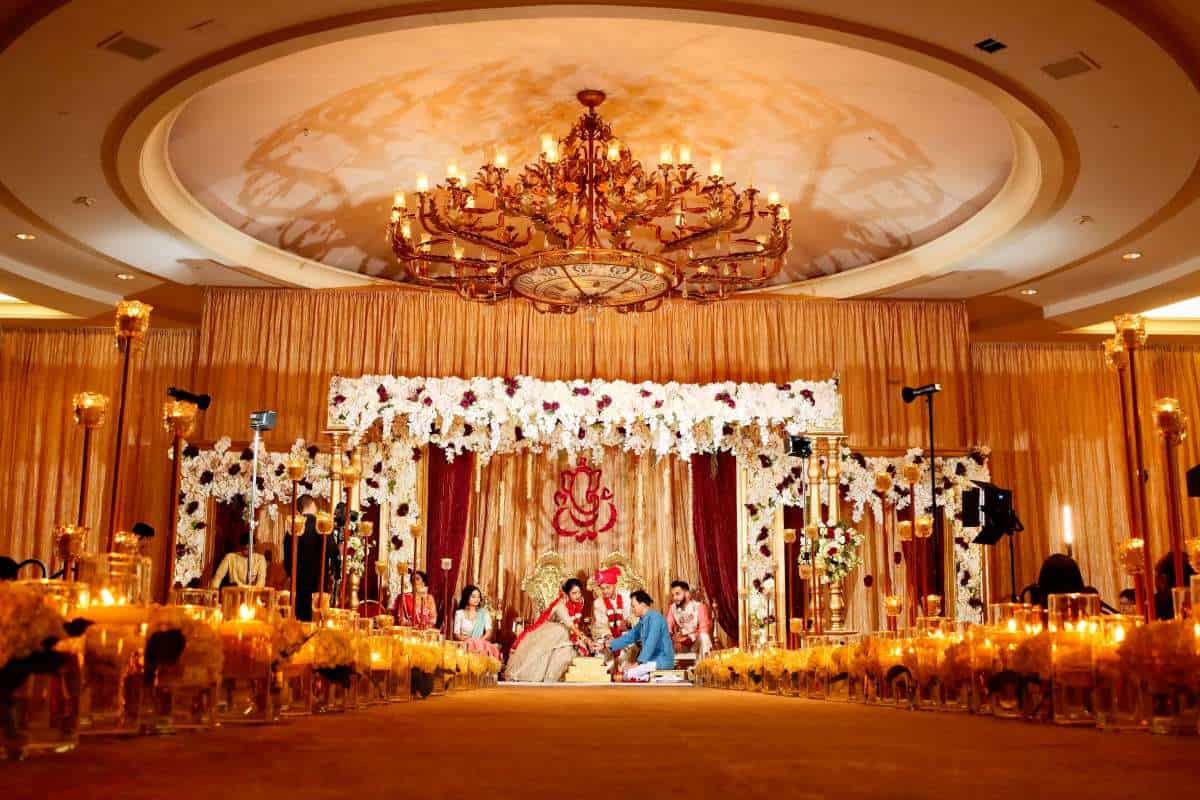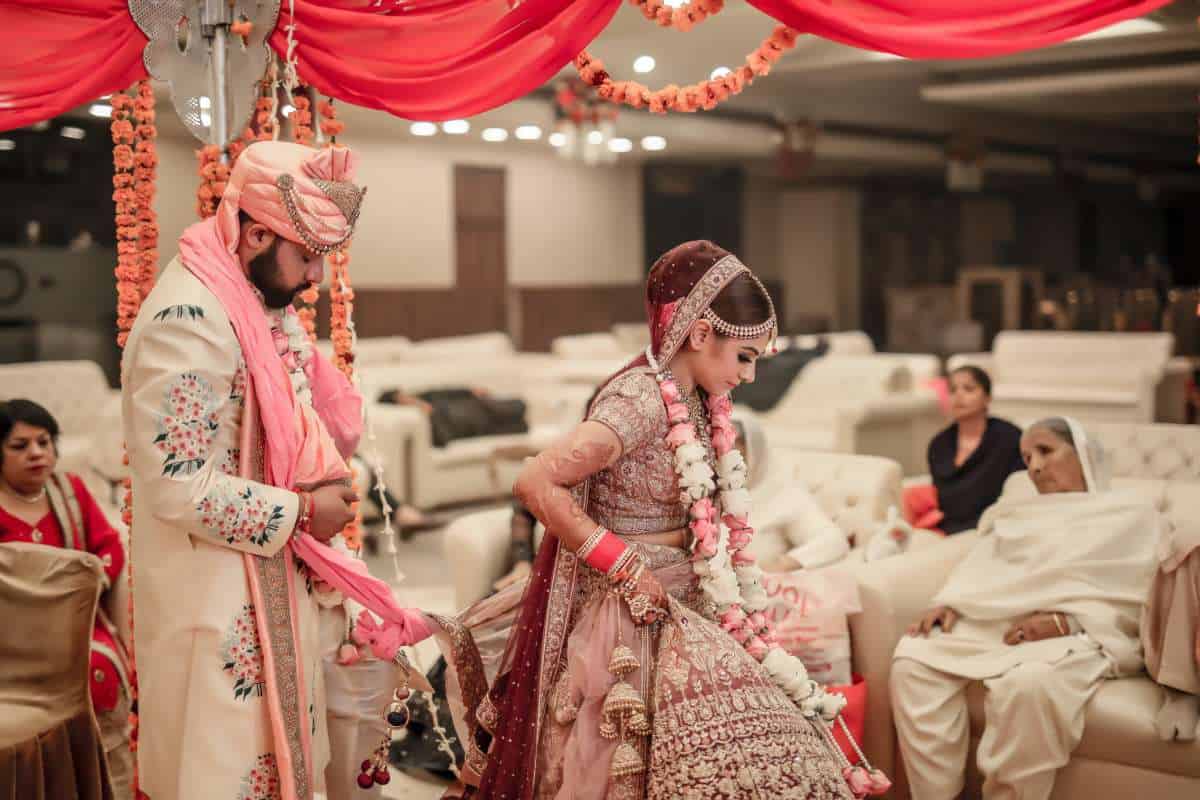If you have been asked to your first Indian wedding, you may be wondering what goes on.
Going to a traditional Indian wedding is a once-in-a-lifetime opportunity to experience a riot of colour, delicious cuisine, moving rituals, and exciting dances all rolled into one massive party.
If you decide to attend a traditional Indian wedding, whether it's Hindu, Muslim, or Sikh, you could feel confused by the wide variety of rites and customs used.
However, if you keep the following advice in mind, you'll be able to attend an Indian wedding with style, ease, and pleasure.
A wedding in India is unlike any other celebration you've ever been a part of. You've never seen so many different cultures come together in one big party with such a delicious and varied spread of food and lively music.
Amazingly, elegance and sophistication manage to shine through the holiday mayhem of large gatherings, religious observances, and sugary treats.
As soon as you step foot inside an Indian wedding, you'll realise that the entire event has been well planned and coordinated, and that your participation in the big celebration depends on your proper participation in those plans. Get ready to be amazed if this is your first time attending an Indian wedding! You're in for some of the liveliest, brightest, and most lavish days of your life.
If you're invited to an Indian wedding, here are some tips for being a respectful guest:
Take it slow; a traditional Indian wedding can go on for a week or more! There are numerous ceremonies and events preceding the wedding itself, beginning with the mehndi and continuing through the sangeet and ending with the reception.
A good visitor will know to expect this and will make every effort to recharge so that they can participate fully and enthusiastically in all of the activities.
Table of Contents
FAQs About Weddings
Indian weddings are traditionally multi-day affairs, and involve many intricate ceremonies, such as the painting of the hands and feet of the bride called a mehndi. Garlands are presented to guests of honor instead of corsages, and lots of flower or rose petals are thrown for good luck.
Giving gifts is a common tradition at Indian weddings. The traditional wedding gift is money, which is regarded as the most thoughtful gift for the couple to start their lives together. This is better done by placing money in a pretty envelope or embroidered bag, along with your best wishes.
Cleavage, dresses that don't cover the knee or clothing that clings to your body is not acceptable for what to wear to an Indian wedding as a guest. For guys, long shirts and long pants are the most appropriate. Dressing conservatively is important, especially for religious ceremonies.
Just like you wouldn't wear white to a Western Wedding, at an Indian Wedding, you should avoid wearing the colors black and white. These colors can be seen as disrespectful since they are common colors when attending a funeral. Also, it's polite to avoid wearing shades of red because the bride typically wears red.
But try not to wear bright red, which is traditional reserved for the bride. Black and white colors should also be avoided as they are considered as colors of mourning or bad luck. Jewelries are also very important part of Indian outfits. Bindis and bangles are most common jewelries for Indian wedding guests.
Dress Modestly
It's not uncommon for people who have never been to an Indian wedding to be unsure of what to wear.
Although there is no hard and fast rule on what to wear to an Indian wedding, it is important to be respectful of the culture by covering up sensitive areas like your shoulders and knees.
Women attending a Hindu or Sikh wedding would be well-served to dress in a sari or lehenga in deference to the ceremony's religious significance, but this is not required.
Men can feel comfortable with suits or the long coat-like sherwani.
You can wear whatever you like to an Indian wedding, even if it's not traditional. Men, meanwhile, should ditch the white button-down in favour of one of several other colours.
Women should stay away from short skirts and exposing tops, and instead go for brightly coloured accessories to liven up their rooms.
It is customary to wear bright colours on this happy occasion.
However, vivid crimson is usually saved for the bride and is best avoided. As they are associated with death and bad luck, the colours black and white should also be avoided.
The addition of jewellery to Indian clothing is also significant. Guests at Indian weddings typically wear bangles and bindis.
You can dress up your ears with a pair of chand balis or jhumkas. If you want to accessorise your neck with something beautiful, choose a necklace with an Indian twist.
You can also accessorise your wedding saree or lehenga with payals and mang tikkas. If you're a man attending the party, finish off your ensemble with a gold chain and some jewelled buttons.
Strand of Silk is a UK-based online shopping site that features Indian garments from prominent Indian fashion designers; it is a good resource for finding the proper dress for attending an Indian wedding.
Please adhere to the dress code established by the hosts if you plan on attending the wedding ceremony. You can ask them when you respond to the invitation, or you can ask them after they tell you the details.
Attendees are not required to wear saris or Indian garb, but should stay away from low-cut tops and miniskirts.
If you're wearing shorts or garments that are too snug, sitting cross-legged on the floor could be uncomfortable.
Removing Shoes
Before entering the sacred section of most religious buildings, visitors are asked to remove their footwear and leave it in a special area.
Socks or stockings are generally appropriate footwear, yet barefeet may be required in some locations.
Prashad Or Blessed Food
'Karah prashad,' a sweet and savoury dish cooked with wheat, sugar, and ghee, is sometimes distributed as a blessing during religious ceremonies, especially those held in a gurudwara (Sikh temple) or in some Hindu rites (clarified butter).
It is accepted with cupped palms or the right hand, then moved to the left for consumption.
Prepare For Strange Hours Of The Day Or Night For The Wedding Ceremony
It's not uncommon for Indian weddings to take place at odd times of day or night. Especially for marriages in northern India, astrology is used to determine an auspicious time of day for the ceremony, and that time is between 2 and 3 in the morning. So that you may plan accordingly and get some rest the day before the wedding, make sure to find out if it is a late night or early morning ceremony.
Plan Accordingly For A Long Wedding
In India, the wedding celebrations can go on for a full week! You may be invited to take part in many aspects of the wedding, beginning with the pre-wedding rituals like Mehndi (henna) and continuing through the main ceremony, which lasts for two to three hours, and ending with the celebration. Get enough sleep and organise your schedule so that you can fully participate in the activities you've been asked to attend.
Learn The Customs
Marriages in India, especially Hindu weddings, are famous for their elaborate and elaborately colourful traditions. Mehndi, Saptapadi (seven steps), and vow recital are just a few examples of the many rituals that take place at a Hindu wedding.
Understanding them will allow you to take maximum advantage of the wedding. During the Mehndi (henna) ritual the evening before an Indian wedding, for instance, the bride and her female friends and family members will have elaborate mehndi patterns made on their hands and feet.
It is often held that the groom and his mother will love the bride more if the mehndi design on her hands is more intense in colour.
It is traditional for the groom to place a ring on the bride's toe or apply vermillion or kumkum to her forehead as a sign of marriage in several cultures.
The reception of barat is a part of any traditional Indian wedding in North India or West India (baraat).
The groom's wedding procession is called a barat. On the day of the wedding, the groom, followed by his family and friends, rides a white adorned mare to the bride's home or, in the case of a traditional Sikh wedding, to the Gurdwara near the bride's home.
Upon his arrival, the Barat will be lavished with gifts and hospitality by the bride's family.
If you've never been to an Indian wedding before, you might be surprised by all the traditions involved.
There is a religious significance to every part of the wedding celebration, from the mehndi to the reading of vows.
Don't be shy about asking questions if you're unfamiliar with any of these practises. All of the guests at an Indian wedding are expected to take part in a variety of rituals, from wishing the bride well with special chants to dousing her in turmeric paste at the Haldi ceremony.
Having an open mind and a willingness to discover the significance of each tradition can benefit not only you, but also the bride and groom.
Gifts
A monetary gift to the newlyweds is appropriate during an Indian wedding even if it is not specified on the invitation.
Traditional methods involve enclosing cash, gift certificates, and well wishes in a lovely envelope or embroidered bag. It is good luck to spend money that ends in the number one, such as Rs. 101, Rs. 501, and so on.
Money Is A Traditional Wedding Gift.
At Indian weddings, it is customary for guests to give each other presents. As they begin their life together, money is the customary wedding gift because it is the most useful.
The ideal way to accomplish this is to enclose some cash and well wishes in a decorative envelope or embroidered pouch.
No of the denomination, monetary gifts to an Indian wedding should total a sum ending in 1.
How much you give depends on your financial situation and your relationship to the bride and groom.
Other decorative goods, jewellery, and silver objects that you would present at a wedding that is not Indian are also appropriate.
Food
Vegetarian fare is typically provided at ceremonies held at Hindu or Sikh temples. Mehndi and sangeet, two additional wedding celebration days, often feature non-vegetarian fare, though this is entirely up to personal preference.
Vegetarianism is not optional during Jain nuptials. Expect halal meat and vegetarian options at Muslim weddings.
Guests are expected to partake in the wedding feast in order to offer the happy couple good fortune, thus it is polite to accept only what you can eat.
For Indians, the wedding feast is a time to celebrate and express their individuality via their love of good food. Each dish and item served at the reception has been meticulously planned by the bride and groom and their families. That being said, take advantage of it!
Don't be afraid to branch out and try something new, especially if you're presented with an Indian meal you're unfamiliar with, and make sure to give your compliments to the hosts (often the bride's family) on their outstanding selections.
You can easily connect with other guests or the hosts over the great food, and you'll really love the creamy mithai offered at the dessert table.
Kissing The Bride
Male wedding guests are not expected to kiss or dance with the bride. It's important to obey tradition on this matter, as even the most independent bride will follow the norm of subdued behaviour on her wedding day.
The newlyweds have a reception the day after the wedding to accept their guests' well wishes and presents from friends and family.
Excellent music keeps the party going, and the attendees keep on dancing. Remember that kissing or dancing with the bride is not part of any sort of costume for the men in attendance. Brides in Indian weddings are expected to be modest, just as they would be in other cultures.
Check Before Taking Pictures
It is generally acceptable to take photographs at an Indian wedding; but, there are certain ceremonies, especially in a Hindu ceremony, where even wedding photographers are not permitted to do so in order to prevent disruption caused by the flash of cameras.
Be sure no one else is shooting before you fire.
Be sure to double-check before you start clicking away at a ceremony.
It should be acceptable for the most part, however during certain rites, especially in a Hindu event, not even the official photographer may be allowed to keep working.
Participate Fully: If you're going to an Indian wedding, participating fully in the ceremony is the single most crucial thing you can do.
It's important to spend time mingling with the bride and groom's relatives, taking part in any celebratory ceremonies, and having a great time on the dance floor at the reception. Finally, an excellent wedding guest is one who has a fantastic time during the reception.
Attending an Indian wedding is a once-in-a-lifetime opportunity, so guests should go in with an open mind and be prepared to participate fully in the festivities.
If you have this positive outlook and remember your manners and demeanour, you will have a great time at a huge fat Indian wedding!
Indians place a high value on family, even if members of the same family don't always get along. When conversing with a senior wedding guest, it's appropriate to show the same respect you'd give to your own parents or grandparents.
Stay away from using their first names when referring to them (Aunty and Uncle are the generic Indian terms, but "Mr." and "Mrs." would work just fine).
They would appreciate your kindness and good manners if you help an elderly person find a seat or fetch food from the buffet.
Have Fun And Enjoy The Experience!
It's not necessary to tread carefully in order to avoid hurting anyone's feelings; most people will accept that you're unfamiliar with local customs. so that no one will harbour any grudges!
They will be grateful that you came and will treat you like a special visitor or even a member of the family.
There is no shame in wanting clarification on the ritual or its expectations. So kick back and take in the vibrant sights and sounds of an Indian wedding!



